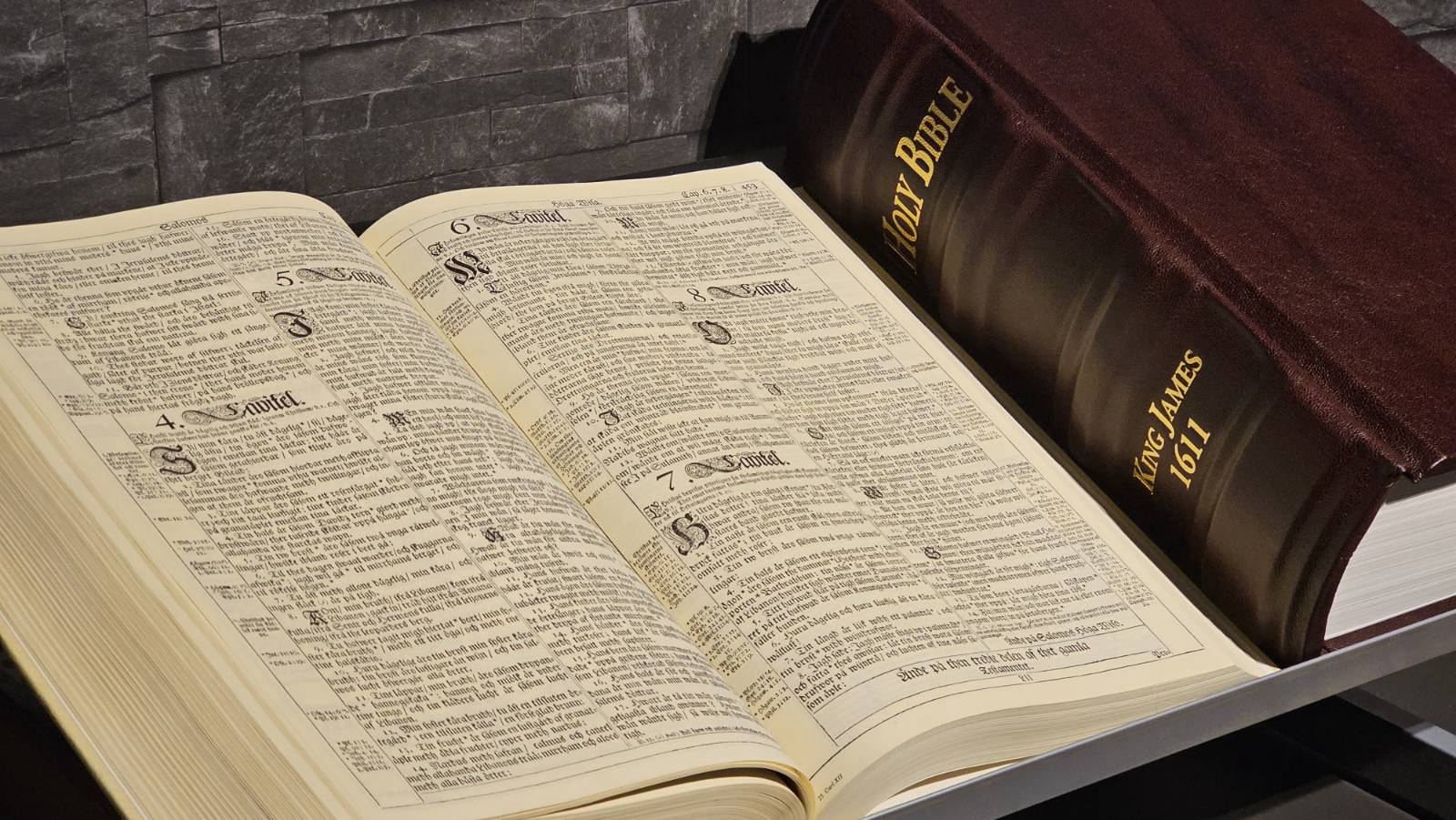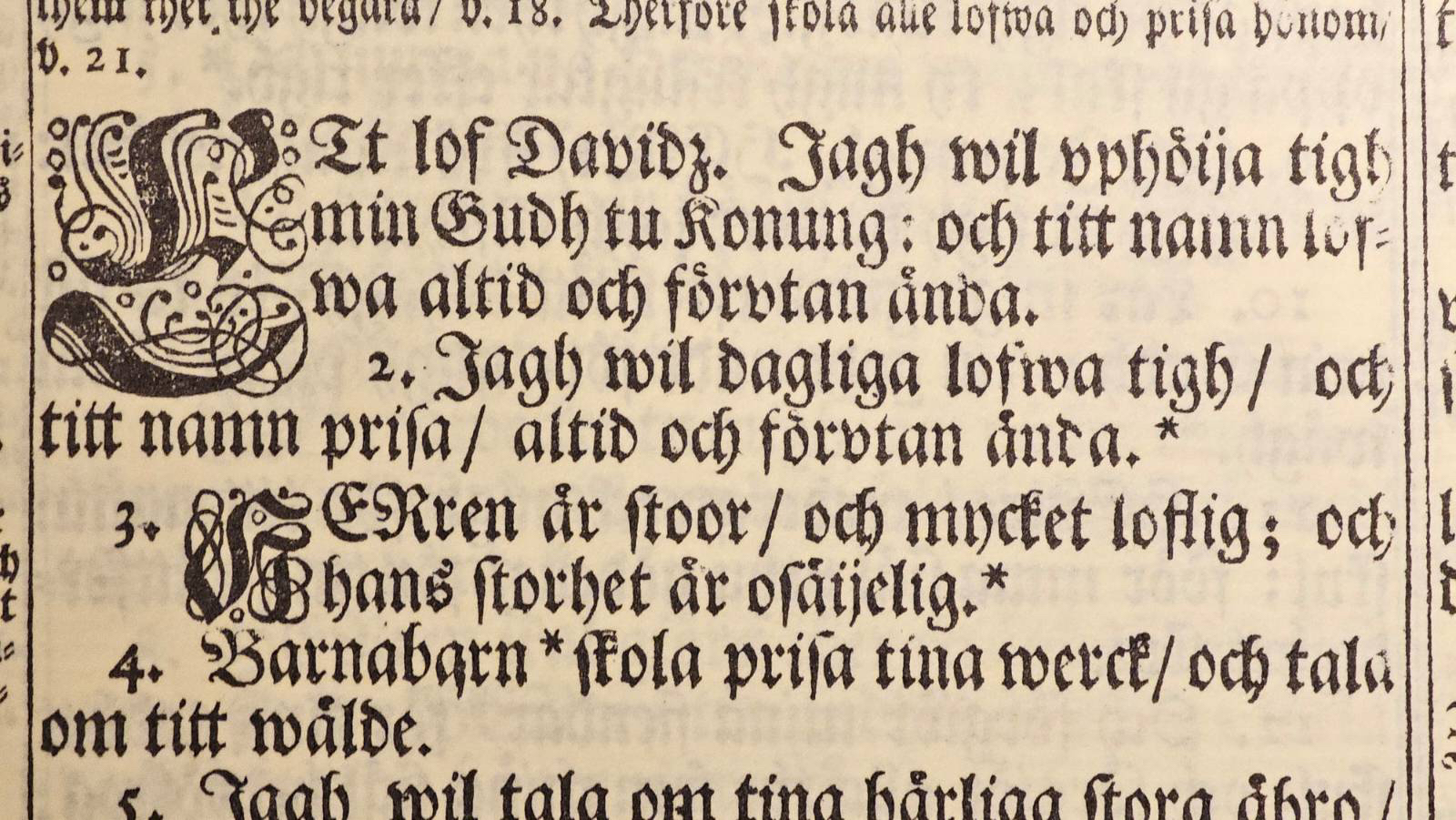Article
About the Charles XII Bible
About King Charles XII's Bible

Charles XII was born at the Tre Kronor Palace in Stockholm on Saturday 17 June G.S. (27 June, N.S.) 1682, the son of King Charles XI and Queen Ulrika Eleonora. Charles XII ruled Sweden from 1697 to 1718 and is best known for his military campaigns and his role in the Great Northern War. But he is also known for the Bible that today bears his name. The Charles XII Bible is mainly based on earlier Swedish translations, notably the Gustav II Adolf Bible of 1618.
If we look at the original manuscript sources on which the Carl XII Bible is based, we arrive at its derivation from the Majority Text:
Old Testament: The basic text of the Old Testament in these early Swedish Bible translations was mainly the Hebrew Masoretic text, but they were also influenced by the Latin Vulgate. (It should also be mentioned that: Vaudois' Old Latin Vulgate is not the same as the later Roman Catholic Latin Vulgate. The Vaudois Vulgate is the preserved Word of God in Old Latin that brought the Gospel to all of Europe. The Roman Catholic Vulgate is completely different. It wrongly mixed the Word of God with the corrupt Alexandrian Greek Old Testament, Apocrypha and New Testament. Modern so-called ‘scholars’ falsely claim that there is only one Latin Vulgate. But there are two: the preserved (Vaudois) and the corrupt (Roman Catholic).
New Testament: For the New Testament, the basic text was largely the Textus Receptus, a Greek text published in the 16th century and the basis for several Bible translations, including Martin Luther's German Bible and the King James Version in English.
A Bible for the people
1703 - It was during the reign of Carl XI that this translation of the Bible was begun, and it was completed during the reign of Carl XII in 1703 by a committee of seven translators, and it was their work that resulted in what would become known as the Carl XII Bible.
1873 - Charles XII obviously has no direct connection with that edition of the Bible. The 1873 Bible is merely a linguistic revision of the Swedish Bible translation made in the 19th century. Charles XII's Bible was generally well received. It is often referred to as the ‘People's Bible’ and became the most widely used Bible for a long time in Sweden. It was a more readable text that was appreciated by both clergy and laity. It became normative and formed the basis for Bible reading in Sweden for over a century. The Bible was often used for educational purposes, both for its Biblical doctrine and as a teaching aid in reading and writing. This central role in education ensured that its language and style influenced generations of Swedes.
We want to show how God has used these Bibles to further his work throughout the ages, which is something that the common people no longer care about. They choose Bibles whose texts have been corrupted by godless people from both Alexandria in Egypt and Rome. Therefore, we want to encourage all Bible-believing readers to choose Bibles with care and from the correct text of manuscripts, from the Majority Text.
Sadly, we see that today's Bibles have abandoned the Majority Text in favour of the critical text, the Minority Text, which is a text that questions whether certain words or verses belong in the Bible. With an attitude like what the devil said to Eve ‘Has God said?’ This creates confusion and distrust of the Bible, where the word of God becomes, instead, the word of men as faith is placed in what scholars and professors say that ‘the Greek or Hebrew text says’, ‘that a better translation is’, or ‘the King James Bible and the Bible of Charles XII do not match the basic text’. What basic text? They are not Bible translations based on the same basic text. This may sound complicated, but when we realise that there are only two manuscript sources, it becomes easier. Indeed, although there are several hundred different English translations of the New Testament, there are only two sources for all these translations and they can all be traced back to one of two families of manuscripts - the Majority Text or the Minority Text.
The majority text that geographically originates from Syria, Antioch comprises about 99% of the over 5,000 extant manuscripts that exist today. These manuscripts were used by the translators of the King James Bible in 1604-1611 and the manuscripts have a high degree of correspondence with each other.
The Minority Text is also called ‘The Critical Text’ and originates geographically from Egypt, Alexandria and comprises about 45 texts which constitute less than 1% of the extant manuscripts that exist today. And Sinaiticus and Vaticanus, the two main Alexandrian manuscripts, do not even agree with each other in over 3000 places (3036+); in the Gospels alone (Matthew, Mark, Luke and John).
Charles XII Bible and King James Version:
TWO CONTEMPORARY GIANTS AND THEIR SIMILARITY

Picture: 1611 King James Version and Charles the Twelfth Bible 1703 (Facsimile editions)
The 1611 King James Version is the authorised Bible of King James I of England and the 1703 Charles the Twelfth Bible is the authorised Bible of King Charles the Twelfth of Sweden.
Both monumental in their own right, the Charles XII Bible and the King James Version stand as pillars in the linguistic and cultural development of their respective nations, Sweden and England. Although these two translations were produced independently, they exhibit similar characteristics that highlight their roles in shaping national identities.
1. Timeliness: Both Bibles were published during a time of national and religious upheaval. While the King James Version was published in 1611, the Charles XII Bible came in the early 18th century. Both translations were a response to the need to standardise and simplify earlier versions.
2. Linguistic Influence: Just as Charles XII's Bible had a major impact on the Swedish language, the King James Version set an unrivalled standard for English, introducing phrases and structures that are still central to modern English.
3. Basis of translation: Both translations were based on the Majority Text in line with previous versions of the Bible in the respective languages. The King James Version was used as a basis, among others:
Tyndale's Bible (1525-1530)
Coverdale's Bible (1535)
Matthew's Bible (1537)
The Great Bible (1539)
Geneva Bible (1560)
Bishop's Bible (1568)
While Charles XII's Bible was based on Gustav II Adolf's Bible and Luther's Bible. In both cases, however, there was an endeavour to achieve greater accuracy in relation to the basic texts (Majority Text, Textus Receptus).
4. Poetic Quality: One of the most outstanding features of both Bibles is their literary and poetic quality. This beauty of language has contributed to their enduring popularity and influence.
5. Cultural Heritage: In both countries, these Bible translations have become cultural landmarks and have played a central role in literary and historical studies.
6. Enduring Popularity: Although newer translations have been introduced, both the Charles XII Bible and the King James Version have retained a special place in the hearts of believers and lovers of literature. They are often quoted and referenced because of their unique quality and historical significance.
7. Disclosure: The Charles XII Bible remained the official Bible translation in Sweden until 1917, when a new translation was introduced. But the new Swedish Bible translation of 1917, unlike Charles XII's Bible, is based on the text-critical text (Minority Text). For the 1917 translation of the Old Testament, the Masoretic Text, which is the basic Hebrew text, was used, but also several critical editions of the Masoretic Text. For the 1917 NT, the translators relied mainly on the Greek text-critical text which includes, among others, from Westcott and Hort, also the Septuagint (LXX) and the Septuagint (a Greek translation of the OT). The Charles XII Bible and the 1917 translation are not based on the same texts. Even the King James Version was ‘replaced’ under false pretences. When the Revised Version (RV) Bible was published in 1881-1885, it was marketed as a revised version of the King James Version (KJV) and the NKJV-New King James Version Bible was also presented with the same false arguments. This is the reason why most modern Bibles are missing verses or words such as Acts. 8:37, Jn. 5:4, 7:53, 8:1-11, Mar. 9:44, 46.
Summary
King Charles XII Bible and King James Bible (King James Version)
Although the Charles XII Bible and the King James Version emerged from different national contexts, they share common themes of linguistic innovation, cultural influence, and enduring legacy. They derive from the same line of manuscripts, the Majority Text, and both have had a good testimony to God, who has shown people salvation through faith in Jesus Christ our only Saviour and brought forth fruit unto the Lord throughout the ages.
The word of God
Yes, we do not want to refer only to the historical and cultural part of this marvellous Bible that God has given us and which has obviously been important for Sweden, both historically and culturally, for over 200 years. What we need to understand about this book is that this is the word of God, which God chose to give to the Swedish people at the time when the leaders of Sweden based the laws of the land on the word of God, which was also blessed by God through good fruit to the Lord and prosperity for the people.
Disclosure
After Charles XII's Bible came the so-called ‘1917 translation’, it replaced the Bible of Charles the Twelfth as the official Church Bible with an updated language and spelling. Sounds good to you, but what nobody talked about was that these two Bibles do not come from the same line of manuscripts. The Charles the Twelfth Bible comes from the Received Text, the Majority Text; not the Minority Text or the Critical Text as it is also called from which the 1917 translation comes. Which is also the case for the King James Version, when the Revised Version (RV) Bible was published in 1881-1885. The RV was marketed as a revised version of the King James Version (KJV) and with the same false arguments, the NKJV-New King James Version Bible was also presented.
Neither the Bible of Charles the Twelfth nor the King James Version can be replaced by any Bible translation based on corrupt texts, which create Bibles that lack whole verses and words. These corrupt texts are also, frighteningly, the basis of most Bibles on the market today.
About the Bible text from the Charles the Twelfth Bible 1703.
Typefaces and spelling
The Charles the Twelfth Bible, published in 1703, was one of the earliest printed Bibles in Swedish, and at that time a Gothic typeface was most often used. Gothic typefaces are known for their decorative and detailed lettering with many curls and points.

Picture: Image example of how the Gothic font looks like in the Charles den Tolftes Bibel 1703.
The text example in the picture is taken from Ps. 145:1-4 and reads
"Ett lof Davidz. Jagh wil vphöija tigh min Gudh tu Konung: och titt namn lofwa altid och förvtan ända. Jagh wil dagliga lofwa tigh/ och titt namn prisa/ altid och förvtan ända. HERren är stoor/ och mycket loflig; och hans storhet är osäijelig. Barnabarn skola prisa tina werck/ och tala om titt wälde.” - Psaltaren 145:1-4 (1703).
”Ett lof Davids. Jag vill upphöja dig, min Gud, du Konung, och ditt Namn lofva alltid och förutan ända. Jag vill dagliga lofva dig, och ditt Namn prisa alltid och förutan ända. Herren är stor, och mycket loflig, och hans storhet är osägelig. Barnabarn skola prisa dina verk, och tala om ditt välde.” - Psaltaren 145:1-4 (1873).
I WILL extol thee, my God, O king; and I will bless thy name for ever and ever. Every day will I bless thee; and I will praise thy name for ever and ever. Great is the Lord, and greatly to be praised; and his greatness is unsearchable. One generation shall praise thy works to another, and shall declare thy mighty acts. - Psa 145:1-4 (KJV)
If you want to see what the typeface of this Bible looks like, we recommend that you look for a physical copy of the book in a library, an antique shop or a museum so that you can fully appreciate the historical typeface in its authentic form and beauty.
In the 1703 edition its spelling is unique as e.g. Jesu Christo, Christum Jesum and LORD in three capitals, corresponding to LORD, (יהוה) JEHOVA or when spelt LORD in two capitals, corresponding to Lord, (אדוני).
"Och hafwer synts Abraham, Isaac och Jacob, att jag will wara deras allsmägtige Gud; men mitt Namn HERRE gjorde jag dem icke kunnigt." - 2 Moseboken 6:3 (1703).
"Och hafver synts Abraham, Isaac och Jacob, att jag vill vara deras allsmägtige Gud; men mitt Namn Herre gjorde jag dem icke kunnigt." - 2 Moseboken 6:3 (1873).
"Och jag visade mig för Abraham, för Isak och för Jakob under namnet Gud den Allsmäktige, men vid mitt namn JEHOVA var jag inte känd för dem." - 2 Moseboken 6:3 (Svenska KJV Bibeln).
And I appeared unto Abraham, unto Isaac, and unto Jacob, by the name of God Almighty, but by my name JEHOVAH was I not known to them. - Exo 6:3 (KJV)
The castle Tre Kronor
(Picture 1 * Computer generated model of the Swedish castle Tre Kronor)

NOTE!
BILD 1: *Computer generated model of the Swedish castle Tre Kronor ("Three Crowns") in Stockholm. This file is licensed under the Creative CommonsAttribution-Share Alike 3.0 Unported license. MLindner6, CC BY-SA 3.0 <https://creativecommons.org/licenses/by-sa/3.0>, via Wikimedia Commons. https://commons.wikimedia.org/wiki/File:Section,_through_castle.jpg